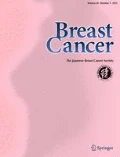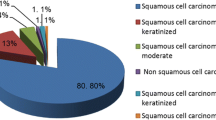Abstract
Background
During the last decades, a great interest was given to viral etiology of breast cancer. Indeed, due to recent technical improvements and some encouraging new results, it has been a resurgence of interest in the possibility that a substantial proportion of human breast cancers may be caused by viral infections. High-risk genotypes of human papillomavirus (HPV) have been found in breast cancer cases. In the present study, we aimed to assess the presence of HPV DNA in breast cancer cases from Rwanda and to evaluate the association between HPV infection and clinico-pathological features.
Methods
Therefore, a total of 47 archived formalin-fixed paraffin-embedded biopsies were collected and complete information was recorded. HPV detection and genotyping were done by PCR amplification and DNA sequencing.
Results
Overall, HPV DNA was found in 46.81% of cases, HPV16 being the most prevalent subtype (77.27%) followed by HPV33 (13.64%) and HPV31 (9.09%). Comparison of HPV with clinico-pathological features showed no significant difference between HPV infection and breast localization, histological subtype, clinical stage, tumor grade, and intrinsic molecular subtypes.
Conclusions
These findings provide evidence of high prevalence of high-risk HPV in Rwandese patients with breast cancer and suggest that high-risk HPV infections could be a risk factor associated with human breast cancer development.
Similar content being viewed by others
References
Kantelhardt EJ, Cubasch H, Hanson C. Taking on breast cancer in East Africa: global challenges in breast cancer. Curr Opin Obstet Gynecol. 2015;27:108–14. https://doi.org/10.1097/GCO.0000000000000139.
Ferlay J, Soerjomataram I, Ervik M, Dikshit R, Eser S, Mathers C et al. GLOBOCAN 2012 v1.0, Cancer incidence and mortality worldwide: IARC Cancer base no. 11 [Internet]. Lyon: International Agency for Research on Cancer. 2013. http://globocan.iarc.fr.
Ferlay J, Shin H-R, Bray F, Forman D, Mathers C, Parkin DM. Estimates of worldwide burden of cancer in 2008: GLOBOCAN 2008. I. Int J Cancer. 2010;127(12):2893–917. https://doi.org/10.1002/ijc.25516.
Jung SJ, Song M, Choi JY, Song N, Park SK, Yoo KY, et al. Association of selected medical conditions with breast cancer risk in Korea. J Prev Med Public Health. 2013;46:346–52. https://doi.org/10.3961/jpmph.2013.46.6.346.
Stewart BW, Kleihues P. World cancer report. Lyon: IARC Press; 2003.
Amarante MK, Watanabe MAE. The possible involvement of virus in breast cancer. J Cancer Res Clin Oncol. 2009;135:329–37. https://doi.org/10.1007/s00432-008-0511-2.
Wang F, Hou J, Shen Q, Yue Y, Xie F, Wang X, et al. Mouse mammary tumor virus-like virus infection and the risk of human breast cancer: a meta-analysis. Am J Transl Res. 2014;6(3):248–66.
Huo Q, Zhang N, Yang Q. Epstein–Barr virus infection and sporadic breast cancer risk: a meta-analysis. PLoS One. 2012;7(2):e31656. https://doi.org/10.1371/journal.pone.0031656.
Bae J-M, Kim EH. Human papillomavirus infection and risk of breast cancer: a meta-analysis of case- control studies. Infect Agents Cancer. 2016;11:14. https://doi.org/10.1186/s13027-016-0058-9.
Damin APS, Karam R, Zettler CG, Caleffi M, Alexandre COP. Evidence for an association of human papillomavirus and breast carcinomas. Breast Cancer Res Treat. 2004;84:131–7.
Delgado-García S, Martínez-Escoriza J-C, Alba A, Martín-Bayón T-A, Ballester-Galiana H, Peiró G, et al. Presence of human papillomavirus DNA in breast cancer: a Spanish case–control study. BMC Cancer. 2017;17:320. https://doi.org/10.1186/s12885-017-3308-3.
Band V, Zajchowski D, Kulesa V, Sager R. Human papilloma virus DNAs immortalize normal human mammary epithelial cells and reduce their growth factor requirements. Proc Natl Acad Sci. 1990;87:463–7.
Yasmeen A, Bismar TA, Dekhil H, Ricciardi R, Kassab A, Gambacorti-Passerini C, et al. ErbB-2 receptor cooperates with E6/E7 oncoproteins of HPV Type 16 in breast tumorigenesis. Cell Cycle. 2007;6(23):2939–43. https://doi.org/10.4161/cc.6.23.4949.
Hachana M, Ziadi S, Amara K, Toumi I, Korbi S, Trimeche M. No evidence of human papillomavirus DNA in breast carcinoma in Tunisian patients. Breast. 2010;19(6):541–4. https://doi.org/10.1016/j.breast.2010.05.007.
Joshi D, Case G. Are viruses associated with human breast cancer? Scrutinizing the molecular evidence. Breast Cancer Res Treat. 2012;135:1–15. https://doi.org/10.1007/s10549-011-1921-4.
Simoes PW, Medeiros LR, Pires PDS, Edelweiss MI, Rosa DD, Silva FR, et al. Prevalence of human papillomavirus in breast cancer a systematic review. Int J Gynecol Cancer. 2012;22:343–7. https://doi.org/10.1097/IGC.0b013e31823c712e.
de Villiers E-M, Sandstrom RE, Hausen H, Buck CE. Presence of papillomavirus sequences in condylomatous lesions of the mamillae and in invasive carcinoma of the breast. Breast Cancer Res. 2005;7:R1–11. https://doi.org/10.1186/bcr940.
Goldhirsch A, Wood WC, Coates AS, Gelber RD, Thurlimann B, Senn H-J, et al. Strategies for subtypes—dealing with the diversity of breast cancer: highlights of the St Gallen International Expert Consensus on the Primary Therapy of Early Breast Cancer 2011. Ann Oncol. 2011;22:1736–47. https://doi.org/10.1093/annonc/mdr304.
Husnjak K, Grce M, Magdic L, Pavelic K. Comparison of five different polymerase chain reaction methods for detection of human papillomavirus in cervical cell specimens. J Virol Methods 2000;88:125–134.
Fernandes A, Bianchi G, Feltri AP, Pérez M, Correnti M. Presence of human papillomavirus in breast cancer and its association with prognostic factors. eCancer. 2015;9:548. https://doi.org/10.3332/ecancer.2015.548.
Corbex M, Bouzbid S, Traverse-Glehen A, Aouras H, McKay-Chopin S, Carreira C, et al. Prevalence of papillomaviruses, polyomaviruses, and herpesviruses in triple-negative and inflammatory breast tumors from algeria compared with other types of breast cancer tumors. PLoS One. 2014;9(12):e114559. https://doi.org/10.1371/journal.pone.0114559.
Elamrani A, Ennaji MM, Benhessou M, Attaleb M, El Mzibri M, Corbex M. Detection of human papillomavirus dna in breast cancer in moroccan woman. Ann Oncol. 2013;24(3):45. https://doi.org/10.1093/annonc/mdt086.12.
El-shinawi M, Mohamed HT, Abdel-Fattah HH, Ibrahim SAA, El-Halawany MS, Nouh MA, et al. Inflammatory and non-inflammatory breast cancer: a potential role for detection of multiple viral DNAs in disease progression. Ann Surg Oncol. 2015. https://doi.org/10.1245/s10434-015-4888-2.
Wang T, Chang P, Wang L, Yao Q, Guo W, Chen J, et al. The role of human papillomavirus infection in breast cancer. Med Oncol. 2012;29:48–55. https://doi.org/10.1007/s12032-010-9812-9.
de León DC, Montiel DP, Nemcova J, Mykyskova I, Turcios E, Villavicencio V, et al. Human Papillomavirus (HPV) in breast tumors: prevalence in a group of Mexican patients. BMC Cancer. 2009;9:26. https://doi.org/10.1186/1471-2407-9-26.
Islam S, Dasgupta H, Roychowdhury A, Bhattacharya R, Mukherjee N, Roy A, et al. Study of association and molecular analysis of human papillomavirus in breast cancer of Indian patients: clinical and prognostic implication. PLoS One. 2017;12(2):e0172760. https://doi.org/10.1371/journal.pone.0172760.
Yu Y, Morimoto T, Sasa M, Okazaki K, Harada Y, Fujiwara T, et al. Human papillomavirus type 33 DNA in breast cancer in Chinese. Breast Cancer. 2007;7:33–6.
Gumus M, Yumuk PF, Salepci T, Aliustaoglu M, Dane F, Ekenel M, et al. HPV DNA frequency and subset analysis in human breast cancer patients’ normal and tumoral tissue samples. J Exp Clin Cancer Res. 2006;25:515–21.
Akil N, Yasmeen A, Kassab A, Ghabreau L, Darmel A, Al Moustafa AE. High-risk human papillomavirus infections in breast cancer in Syrian women and their association with Id-1 expression: a tissue microarray study Clinical Studies. Br J Cancer. 2008;99:404–7. https://doi.org/10.1038/sj.bjc.6604503.
Correnti M, Medina F, Eugenia M, Rennola A, Ávila M, Fernándes A. Gynecologic oncology human papillomavirus (HPV) type distribution in cervical carcinoma, low-grade, and high-grade squamous intraepithelial lesions in Venezuelan women. Gynecol Oncol. 2011;121(3):527–31. https://doi.org/10.1016/j.ygyno.2011.02.003.
Boumba LMA, Hilali L, Mouallif M, Moukassa D, Ennaji MM. Specific genotypes of human papillomavirus in 125 high-grade squamous lesions and invasive cervical cancer cases from Congolese women. BMC Public Health. 2014;14:1320. https://doi.org/10.1186/1471-2458-14-1320.
Hamidi-Fard M, Fattahi-Abdizadeh M, Makvandi M, Ranjbari N, Mansoori E, Samarbaf-Zadeh A. Detection and Genotyping of Human Papillomavirus in Cervical Tissue Samples in Ahvaz, Southwest Iran. Jundishapur J Microbiol. 2013;6(7):e4569. https://doi.org/10.5812/jjm.4569.
Omire A, Budambula N, Ochieng W, Baliach C, Keros D, Langat H, et al. Assessment of risk predisposition to human papilloma virus through cervical infections screening of women attending an outpatient health facility in Nairobi, Kenya. J Biol Agric Healthcare. 2014;4(22):28–36.
Herrera-Goepfert R, Vela-Chávez T, Carrillo-García A, Lizano-Soberón M, Amador-Molina A, Oñate-Ocaña LF, et al. High-risk human papillomavirus (HPV) DNA sequences in metaplastic breast carcinomas of Mexican women. BMC Cancer. 2013;13:445. https://doi.org/10.1186/1471-2407-13-445.
Ohba K, Ichiyama K, Yajima M, Gemma N, Nikaido M, Wu Q, et al. In vivo and in vitro studies suggest a possible involvement of HPV infection in the early stage of breast carcinogenesis via APOBEC3B induction. PLoS One. 2014;9(5):e97787. https://doi.org/10.1371/journal.pone.0097787.
Kroupis C, Markou A, Vourlidis N, Dionyssiou-Asteriou A, Lianidou ES. Presence of high-risk human papillomavirus sequences in breast cancer tissues and association with histopathological characteristics. Clin Biochem. 2006;39:727–31. https://doi.org/10.1016/j.clinbiochem.2006.03.005.
Lawson JS, Kan C, Iacopetta BJ, Whitaker NJ. Are some breast cancers sexually transmitted? Br J Cancer. 2006;95:1708. https://doi.org/10.1038/sj.bjc.6603502.
Pike MC, Spicer DV, Dahmoush L, Press MF. Estrogens, progestogens, normal breast cell proliferation, and breast cancer risk. Epidemiol Rev. 1993;15(1):17–35.
Brake T, Lambert PF. Estrogen contributes to the onset, persistence, and malignant progression of cervical cancer in a human papillomavirus-transgenic mouse model. Proc Natl Acad Sci. 2005;102:2490–5. https://doi.org/10.1073/pnas.0409883102.
Doorbar J, Quint W, Banks L, Bravo IG, Stoler M, Broker TR, Stanley MA. The biology and life-cycle of human papillomaviruses. Vaccine. 2012;30S(5):F55–70. https://doi.org/10.1016/j.vaccine.2012.06.083.
Acknowledgements
We thank the Biology and Medical Research Unit in CNESTEN and the King Faisal Hospital and Kigali Teaching Hospital staff for their helpful collaboration.
Author information
Authors and Affiliations
Corresponding author
Ethics declarations
Conflict of interest
The authors declare that they have no conflict of interest.
Ethical approval
This article does not contain any studies with human participants or animals performed by any of the authors.
About this article
Cite this article
Habyarimana, T., Attaleb, M., Mazarati, J.B. et al. Detection of human papillomavirus DNA in tumors from Rwandese breast cancer patients. Breast Cancer 25, 127–133 (2018). https://doi.org/10.1007/s12282-018-0831-2
Received:
Accepted:
Published:
Issue Date:
DOI: https://doi.org/10.1007/s12282-018-0831-2




